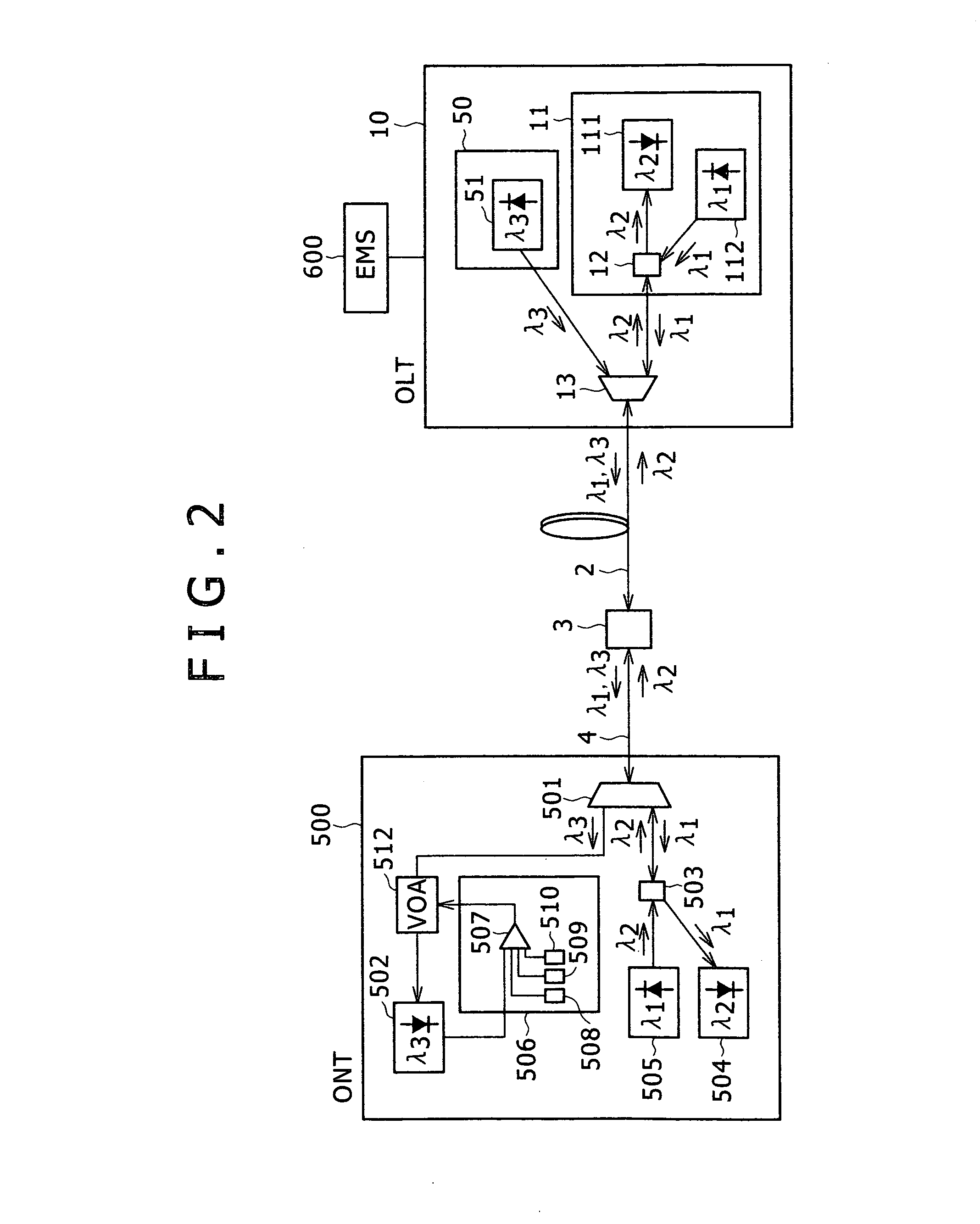Optical termination apparatus and optical transmission system
a technology of optical transmission system and optical termination apparatus, which is applied in the direction of optical elements, multiplex communication, instruments, etc., can solve the problems of insufficient or too high input power in the other onts, insufficient input power of data signal transceiver b>11/b> of the upstream optical wavelength, and insufficient input power of the data signal transceiver
- Summary
- Abstract
- Description
- Claims
- Application Information
AI Technical Summary
Benefits of technology
Problems solved by technology
Method used
Image
Examples
embodiment 1
[0025] Embodiment 1 will be described with reference to FIGS. 2 and 3. Herein, FIG. 2 is a block diagram of a Triple-Play PON system. FIG. 3 is a control flowchart of an ONT. Incidentally, in FIG. 2 and the following figures, a video head end of FIG. 1 is referred to as a video signal transmitter. For illustrative convenience, the video signal transmitter is shown as being provided within the OLT 10. Also, only one subscriber's house is described in the figures.
[0026] In FIG. 2, the Triple-Play PON system includes an OLT 10 and an EMS (Element Management System) 600 that are placed in a central office, an ONT 500 placed in a subscriber's house, an optical splitter 3, a trunk line optical fiber 2, and a termination optical fiber 4. Herein, the EMS 600 is a monitoring device for the Triple-Play PON system. A data signal transceiver 11 of the OLT 10 is connected to a router 20 of FIG. 1. A video signal transmitter 50 of the OLT 10 is connected to a video network 200 of FIG. 1. Further,...
embodiment 2
[0036] Embodiment 2 will be described with reference to FIGS. 4 and 5. Herein, FIG. 4 is a block diagram of an ONT. FIG. 5 is a control flowchart of the ONT. Incidentally, the ONT 500 of FIG. 4 has substantially the same configuration as the ONT 500 of the Triple-Play PON system described using FIG. 2, and the description on the same or similar components will be omitted. Also in the control flow of FIG. 5, the description on the flow parts described using FIG. 3 will be simplified.
[0037] The ONT 500 shown in FIG. 4 is different from the ONT 500 described in FIG. 2 with respect to the following points. That is, that the part using the comparator 507 in FIG. 2 is replaced with an operation instruction circuit 513, where a portion of the reference voltage is changed. Further a CNR / CSO computation circuit 550 is newly provided. Herein, the CNR / CSO computation circuit 550 is a circuit for calculating the CNR (Carrier to Noise Ratio) value and the CSO (Composite Second Order beat) value,...
PUM
 Login to View More
Login to View More Abstract
Description
Claims
Application Information
 Login to View More
Login to View More - R&D
- Intellectual Property
- Life Sciences
- Materials
- Tech Scout
- Unparalleled Data Quality
- Higher Quality Content
- 60% Fewer Hallucinations
Browse by: Latest US Patents, China's latest patents, Technical Efficacy Thesaurus, Application Domain, Technology Topic, Popular Technical Reports.
© 2025 PatSnap. All rights reserved.Legal|Privacy policy|Modern Slavery Act Transparency Statement|Sitemap|About US| Contact US: help@patsnap.com



